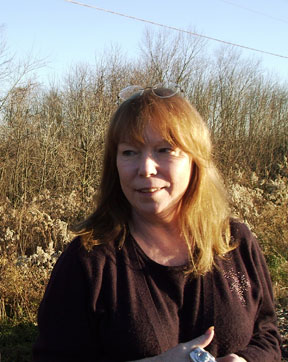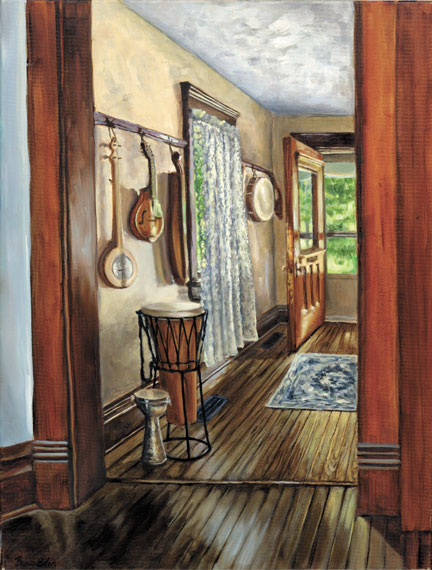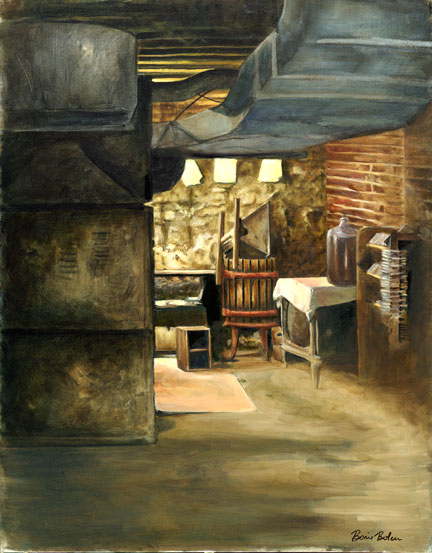
Columbus, Ohio USA
Return to Homepage www.shortnorth.com
Artist Rising
Country Roots, Family Ties Help Shape Artist's Vision, Versatility
By Jennifer Hambrick
July 2009 Issue
Return to Homepage
Artist Bonie Bolen (left) with sister, Elizabeth, a Columbus musician.
Photo/ Rick BorgiaBonie Bolen might not be an artist today if she hadn’t decided early on to do things her way.
But this month she’s the headliner in a show of paintings, canvas murals, jewelry and hand-painted ceramicware by three local artists, at Norka Futon, 780 N. High St. The show’s opening during the July 4 Gallery Hop will feature live music performed by Bolen’s sister, Columbus singer/songwriter and African drummer Elizabeth Bolen.
Bonie Bolen’s paintings on themes as varied as love, dancing, hope and communication, and canvas backdrops depicting moments in the history of blues, will appear in the show.
Bolen, 32, invited fellow artists Concha Castaneda and Dimitris Papaleonardos to exhibit alongside her. Castaneda’s line of “Divine Designs” showcases silver Stars of David, crescents and St. Brigid’s crosses as pendants, belt buckles and decorations soldered onto rings. Her ceramic creations range from earth-toned bowls to brightly colored pieces bathed in shiny shellack.
A native of the Greek island of Aegina, Papaleonardos began painting sea creatures and abstract symmetrical designs on ceramic plates about ten years ago. His creations tell the story of Aegina, a once-great sea power, in designs of the island’s traditional trireme ships and other sea imagery, and in narratives Papaleonardos hand paints in Greek and English. This month’s show is the first public display of his work in Columbus.
To get where she is today, Bolen has followed a rambling path from pizza delivery driver to self-taught mural painter through three Ohio towns. Her commitment to obeying her own artist’s voice has guided Bolen seemingly closer to becoming a professional artist. And all along the way her family’s passion for music has looked over her shoulder and crept into her canvases.A Musical Family
Bolen’s father, John Bolen, grew up in Bayonne, New Jersey. That’s where he met Peggy Schmidt, who had settled in Newburg, New York, when in her 20s and would come to Bayonne to visit family. The ‘60s folk music revival was in full swing. John Bolen remembers as a teenager picking up the guitar his mother had given him for Christmas several years before and working out tunes from Bob Dylan’s first album. He got hooked.
“I got turned on to folk music because it was such a wide world. Folk music encompasses gospel, Blues, Cajun, old-timey bluegrass. It goes on and on,” Bolen said.
Years later, having grown into a committed relationship, John and Peggy were milking cows at a dairy farm in rural New Jersey when country life called them. They set up house in Glennville, West Va., where they could be closer to the earth and to the American roots music they loved. By a fluke John became a cobbler. His grandfather, Pasquale DeCamillis, had brought the trade with him from Italy when he came to America and had owned several shoe repair shops around New York City. When DeCamillis died, John Bolen inherited his machines but not his know-how. In Glennville, Bolen learned the shoe repair trade through the school of hard knocks.
“I
didn’t know the left from the right,” John Bolen said. “Nobody trained me. I ruined a few pairs of shoes. It was a real struggle for the first couple of years.”
During those years, he dissected shoes to learn how they had been built. He studied well-mended shoes and borrowed the techniques their surgeons had used. He eventually got good enough that the owner of another nearby shoe repair shop asked him to manage the store temporarily while he looked for a permanent shopkeeper.
Still, for John and Peggy it had been difficult to make a living in West Virginia. John Bolen planned to open a shoe repair shop in Parkersburg, W. Va. One day he took a trip to Marietta and stopped in one of the two shoe repair shops downtown looking for a piece of equipment. He learned there that the owner of Marietta’s other shoe repair shop wanted to sell his business.
“Dig this,” said Bolen, a self-described hippie, “$5,000, lock, stock and barrel. Even back in ’77 that was cheap.”
Cobbler John’s shoe repair shop was born.
John and Peggy Bolen moved to 60 acres outside Macksburg, Ohio, even as their first daughter, Bonie, was about to make her terrestrial debut. When that day came, they traveled to Grantsville, W. Va., where Peggy’s doctor welcomed Bonie into the world. Then they drove back to their new Ohio home.Country Music
John Bolen “I feel really blessed to have been raised where I was,” Bonie Bolen said of her rural childhood home.
Bolen remembers the vegetables from the garden, the cheese her mother would make from the milk of their cows and the nearby woods that taught Bolen how to see – really see – everything she noticed.
“I loved walking in the woods, so a lot of times I would go off and walk in the woods by myself,” Bolen said. “I have a real detailed eye when it comes to drawing, and I think that when you spend a lot of time in the woods, because there’s so much going on and there’s so much detail and so much to look at, I think that kind of helps train your eye.”
She also remembers her father’s vineyards – row upon row of grapevines lining the land – and the people who came during grape harvesting time with their banjoes and fiddles and guitars and voices to play and sing folk music in hootenannies at the Bolen homestead.
Peggy and John Bolen (above and right) laid the groundwork for their children's artistic development. The parents' passion for music, nature, and country living nurtured and encouraged their daughters' sensitivity to the fine arts. “Sometimes there’d be elderly people from out in the country that would come over, and they’d play old-timey and bluegrass. Sometimes blues musicians would come out, and folk musicians,” Bonie Bolen said.
John Bolen would sing and play his guitar and banjo at these gatherings, and Peggy would play her dulcimer and piano. But even after the grapes had been plucked from their vines, the pickin’ and strummin’ didn’t stop.
“We would sit around the living room and play and sing together,” said Elizabeth Bolen, who says her family’s interest in music fostered her own.
“We played music just about every single night,” said Peggy Bolen. She made sure her daughters were taking some kind of music lessons – piano lessons, singing lessons, saxophone lessons – almost all the time.
Once Bonie had finished high school she went to college, like everyone thought she should do. She entered the University of Cincinnati to study fine arts.
“I knew I wanted to make art, and I knew I didn’t want to do advertising,” Bolen said. “I knew I had talent, I knew I had ability,
I knew I had interest.”
She also had intuition, which told her something at Cincinnati wasn’t quite right.
“I kind of felt like, if I pay all this money for a big education, I know (a career in fine arts) is going to be a struggle, so why don’t I see what I can do on my own?” Bolen said.
After a semester at Cincinnati, Bolen returned to Marietta to take classes at Washington State Community College and devise a plan for developing a career as an artist. She took a concentration of drawing classes and also courses across the humanities.
Bolen stopped taking classes when, again, she discovered they were taking all her time and drowning out her own voice.
“I just wanted to explore what I could do on my own,” Bolen said. “I felt like in order to grow with my work I just needed to spend more time with it.”
Painting on the Walls
Come On In, 18" x 24" oil by Bonie Bolen. After Bolen left community college, an artist friend encouraged her to take up painting. Her father gave her a room next to his shoe repair shop to use as a studio. In 1997 Bolen got a job with some established mural painters to paint scenes on the walls inside the Marietta Brewing Company, a downtown Marietta restaurant and bar. At that time John Bolen had been president of the Marietta Blues, Jazz and Folk Music Society for nine years. As he was planning the society’s 1998 River City Blues Festival, Bonie had an idea.
“She said, ‘Behind the musicians is a blank wall. Why couldn’t we put up a mural or a backdrop?’” John Bolen said. “I said, ‘That sound like a great idea.’”
Bonie Bolen painted a four-by-five-foot canvas backdrop depicting a piano and trumpeting “River City Blues Festival.” She had hung the canvas on one of the walls of her studio and painted it as though painting a mural.
In 1999 Bolen moved to Columbus to return to school, this time at Ohio State. She was searching for a career path in art, but yet again didn’t like how that search limited her painting time.
“I felt like any career was going to take me away from my painting, yet at the same time I was trying to find something,” Bolen said. Again she scrapped school and, after an unsuccessful road trip out west with a friend, landed in Marietta two years later.
Bolen asked her dad if the contractors who came through his shoe repair shop knew anyone who needed a mural painter. He asked around and learned of a now-
defunct women’s decorative painting collective in nearby Mineral Wells, W. Va., called The Painters Menagerie. They took Bolen on, teaching her some of the tricks of the decorative painting, or “faux” painting, trade – how to paint drywall to look like marble, for instance, or aged plaster.
Bolen also got a job delivering pizzas for East of Chicago Pizza in Marietta and even there created opportunities to paint.
“It was good money,” Bolen said, “And it was one of my favorite jobs.”
In 2005, after Bolen had been working for East of Chicago for almost two years, the restaurant’s owner, Brenda Myers, mentioned that her 12-year-old son wanted a mural of Brutus Buckeye on his bedroom wall.
“And I just remember (Bonie) saying, ‘I could probably look at it and come up with something,’” Myers said.
Bolen looked at the boy’s room.
“And she came up with a couple of drawings, and we just said, ‘No way. Why are you delivering pizzas?’”
Two weeks later the mural was finished.
It was a disaster for many downtown Marietta businesses, including East of Chicago Pizza, when the Ohio River flooded Marietta later that year.
“After she did my son’s room, I said, ‘We could really use you to fix up the dining room,’” Myers said.
Bolen offered to help paint the restaurant’s water-stained walls with flat paint and to decorate them with murals depicting scenes from Marietta’s history. She pulled photos from the historical society and, with Myers, chose scenes to copy for the murals. Today, panoramas of a sternwheeler, children playing along the Ohio River and a boat of distraught passengers rowing on high water after the flood of 1936 cover the restaurant’s walls.
Myers says her customers may have suspected Bolen wouldn’t be long at East of Chicago.
“People started coming in here and asking, ‘Who did this, who did this?’ and we told them, ‘It’s one of our drivers.’ And everybody said, ‘Why does she deliver pizzas, because she needs to be somewhere else,’” Myers said.
Bolen stayed in Marietta a while longer, but her music festival backdrops started traveling. In 2006 Jim Gelder, a trustee and active volunteer with the Columbus Blues Alliance, was overhauling his organization’s annual Traditional Acoustic Blues Festival. He wanted sharper acts, a better venue and a photo gallery. He also wanted a backdrop behind the main stage like the one he had seen at Marietta’s River City Blues Festival the year before. Gelder borrowed one of Bolen’s backdrops – a representation of Memphis’ Beale Street, a cradle of the Blues – from Marietta for Columbus’ 2006 Acoustic Blues Festival. The Columbus Blues Alliance has commissioned Bolen to paint a backdrop for each year’s festival since then as an attraction that Gelder says isn’t common at blues festivals.
“A lot of stages will have a black curtain backdrop or a poster,” Gelder said. “We wanted to make this event, so many aspects of it, different from just another blues show. We get to tell people this painting was commissioned for this event, trying to bring something different and unique that people usually don’t see.”Finishing School
The Recipe, by Bonie Bolen, 2004. When The Painters Menagerie closed in 2005, Bolen was left with few artistic options in Marietta. She returned to Columbus to find more opportunities to paint. A year earlier Bolen had used some of the money she had saved up delivering pizzas to take a course in decorative painting at The Finishing School, in Mechanicsburg, Pa. Her training there helped her land another job in decorative painting.
“She is very artistic,” said Lori Stebelton, owner of the Ashville, Ohio, interior design firm Chloe’s Closet, where Bolen has worked since 2008. “She sees color and art in everything that she looks at. Hers is just a natural talent. Of the painters that we’ve had, she’s by far the most artistic.”
Stebelton says Bolen’s artistry recently enabled her firm to offer a service it can’t usually provide. A few years ago a former client had had an artist paint a portrait of her young daughter. Last year the client approached Chloe’s Closet to commission a portrait of her younger daughter in the same style as the older portrait. Bolen painted the second portrait using a photograph of the child as reference art.
“She mimicked the style of (the first painting), the bright colors that she used,” Stebelton said. “All of it was perfectly right on and the client was just thrilled.”
Now Bolen spends most of her days painting. The decorative painting keeps a brush in her hand and pays the rent, allowing her to continue working on her canvases in her spare time. Bolen’s representational paintings betray a romantic approach to life and human nature. In one of her paintings a man and a woman dance together in an embrace under subdued lighting. There’s a certain innocence in Bolen’s flat, unassuming brushwork that seems appropriate for her spiritual understanding of intimate dance.
“I think dancing releases parts of us that are freedom centers,” Bolen said.
Her canvas Shine shows a brown-haired female form encircled by a field of yellow with blue and white asterisk-like stars.
“It’s kind of about some women I know who were going through some pain, and it’s just to remind you to shine,” Bolen said.
The hope that Shine communicates in a pure, almost naïvely straightforward style is absent from Bolen’s canvas Communication, in which the wires of a cluster of communication towers suggest a cat’s cradle of mixed signals. As with Shine, Bolen’s inspiration for Communication came from real-life. “I was thinking about the dynamics of some people that I knew,” Bolen said.
When Bolen painted her canvas backdrop Traditional Instruments for one of the Marietta Blues, Jazz and Folk Music Society’s Celtic music concerts, she wasn’t just fulfilling a commission. The backdrop shows a panoply of instruments hanging on a wooden barn wall. There’s a Celtic flute and some bagpipes, and her father’s bodhran, her mother’s dulcimer and her sister’s guitar – a hand-me-down from their dad – also hang on the wall. The backdrop lives up to its title: the sounds of these instruments echo today through centuries of folk music, through the Bolen family’s traditional jamborees and right through Bonie Bolen’s canvas.To see more artwork by Bonie Bolen, visit www.bjfm.org/muralartists/bonie.htm
© 2009-2018 Short North Gazette, Columbus, Ohio. All rights reserved.
Return to Homepage www.shortnorth.com




